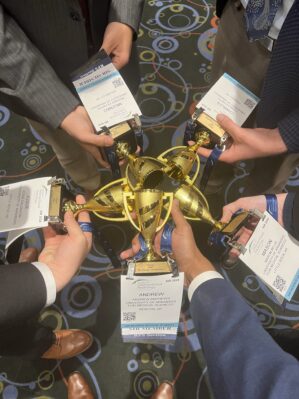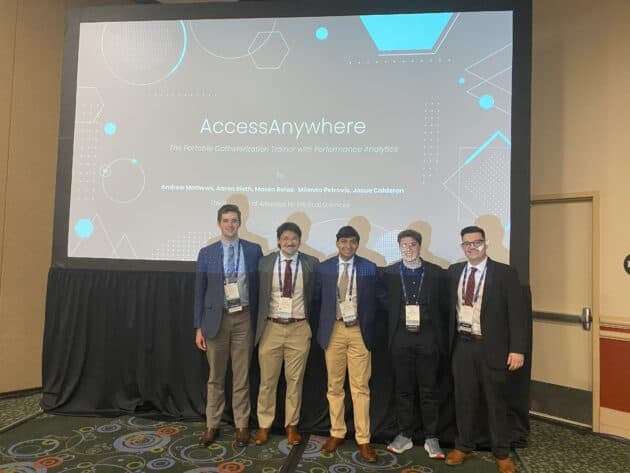About the Competition
The Society of Interventional Radiology (SIR) Medical Student Council Biodesign Innovation Committee hosted its annual Biodesign Competition, wherein medical students were tasked with solving problems faced in Interventional Radiology (IR) in a collaborative setting together with peers and IR mentors. Congratulations to the UAMS team on taking home top honors for their project, the “Access Anywhere” Catheterization Trainer!

This year’s theme was “Telehealth in IR,” encompassing virtual reality (VR), care inequities, training/education, and global telehealth in IR. Teams of students from across the country were challenged to develop an innovation to address this year’s prompt, with the first round consisting of a technical report write-up and a PowerPoint presentation submission. The presentations were delivered virtually on Zoom to a panel of judges, and the top two highest-scoring teams were invited to present an expanded version of their initial presentations to a live panel of IR attendings on March 23 at the SIR annual meeting in Salt Lake City, Utah, to determine the winner.
The 2024 UAMS biodesign team was composed of five College of Medicine students: Andrew Mathews (M2), Aaron Rieth (M2), Mason Belue (M3), Milenko Petrovic (M2), and Josue Calderon (M1). They—alongside faculty mentors Dr. Mollie Meek and Dr. Bob Dixon with the UAMS Division of Interventional Radiology—conducted interviews, distributed surveys, and performed extensive research to ultimately address this year’s competition prompt of telehealth training/education in IR. Below is a short description from the team of their device, AccessAnywhere:
Mini Abstract
Effective training of students, residents and fellows in IR is far from an intuitive task. Teaching technical, minimally invasive procedures with heavy utilization of live imaging modalities is both a costly and laborious undertaking. This training was further impacted by the COVID-19 pandemic, where significant reductions in hands-on training shifted educational efforts toward both remote and simulated learning along with an increased focus on telehealth medicine. Educational innovations are thus necessary to improve access, reduce cost and expand the scope of procedural training within IR.

Given this clinical context, our team sought more information about procedural training from clinical professionals in both the greater Little Rock and Northwest Arkansas regions. Our findings revealed that some of the most common IR procedures incorporate central and peripheral venous catheterization, making proficiency in these techniques a necessity. The physicians we interviewed during our ideation process likewise expressed concerns with effectively educating residents about these techniques, particularly regarding the “feel” of the catheter in one’s hand as a means to understanding when applied pressure is enough or when it may be too much and damage blood vessels.
Given this demonstrated need for expanded procedural training opportunities in IR, as expressed in both the literature and in our interviews, we devised the AccessAnywhere catheterization trainer. This device represents both a software and a hardware innovation, combining an affordable and portable physicalized vascular model with computer-mediated sensing, recording and feedback capabilities to give IR fellows, residents, and even interested students an opportunity to practice this fundamental skill in a low-pressure environment before attempting it “for real” in the IR suite.
